Cleft Lip And Palate Important Notes
Classification of cleft lip and palate:
- Davis & Ritchie Classification:
Group 1 – Prealveolar clefts – Involves only lip
Group 2 – Post alveolar clefts
Involves palate and alveolar ridge
Group 3 – Alveolar clefts
Involves the palate alveolar ridge and lip - Veau’s Classification [1931]:
Group 1 – Involves only soft palate
Group 2 – Involves palate up to incisive foramen
Group 3 – Involves palate, lip, and alveolar ridge unilaterally
Group 4 – Involves palate, lip, and alveolar ridge bilaterally - Carnahan’s Stripped ‘Y’ Classification:
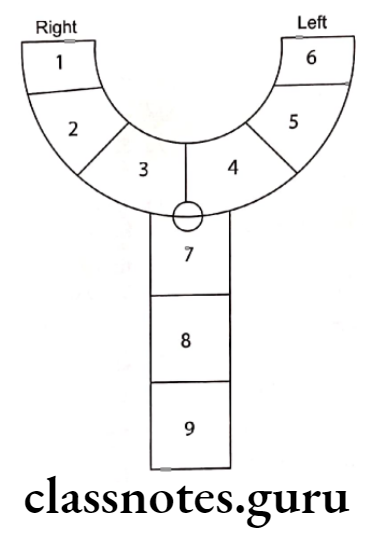
- Block 1 and 6 – Lip
- Block 2 and 5 – Alveolus
- Block 3 and 4 – Hard palate anterior to incisive foramen
- Block 7 and 8 – Hard palate posterior to the incisive foramen
- Lahshal Classification:
- L – Lip
- A – Alveolus
- H – Hard palate
- S – Soft palate
- H – Hard palate
- L – Lip
Treatment protocol:
- Immediately after birth
- Pediatric consultation
- First few weeks
- Hearing testing
- At 10 – 12 weeks
- Surgical repair of lip
- 3 months after palate repair
- Speech & language repair
Read And Learn More: Orthodontics Short And Long Essay Question And Answers
- 3 – 6 years
- Soft palate lengthening
- 5 – 6 years
- Pharyngeal surgery
- At 7 years
- Orthodontic treatment phase 1
- 9 – 11 years
- Pre-alveolar bone grafting
- 12 years or later
- Full orthodontic treatment phase 2
- 15 – 18 years
- Placement of implant
- 18 – 21 years
- Surgical advancement
- Final nose & lip revision
- Rhinoplasty
Millard’s rule:
- Timing of cleft lip repair should be when hemoglobin is 10 gm%, age 10 weeks, weight 10 lbs, and total leukocyte count less than 10,000 per mm3
Cleft Lip And Palate Long Essays
Question 1. Write in detail about the development of the maxilla. Elaborate on etiology and treatment of cleft palate.
Answer.
Development Of Maxilla:
According to Moyers, development refers to all the naturally occurring unidirectional changes in the life of an individual from its existence as a single cell to its elaboration as a multi-function unit terminating in death.
Development Of Pre-Natal Maxilla:
- Around the 4th week of IU life, a prominent bulge appears on the ventral aspect of the embryo.
- Below it, there develops a depression called stomodeum, primitive mouth
- Downward projection developing from the mesoderm overlaps the stomodeum called the front-nasal process
- By around 4th week of IU life, the mandibular arch one of the 5 branchial arches develops
- The mandibular arch gives off a bud from its dorsal end called the maxillary process
- Thus, stomodeum is overlapped

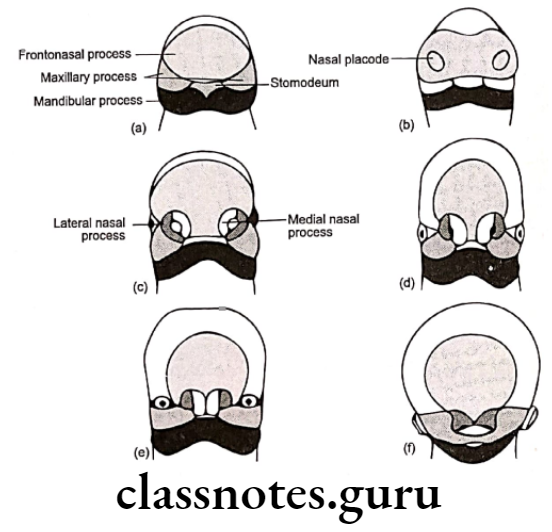
Postnatal Growth Of Maxilla:
- Its growth occurs as
Displacement:
- Primary and secondary displacement leads to the growth of maxilla
- Primary displacement is seen in a forward direction due to the growth of its tuberosity in a posterior direction
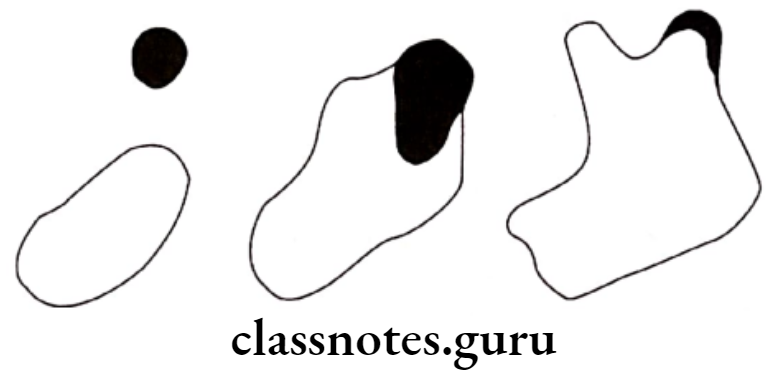
Growth at sutures – Sutures involved are:
- Fronto – nasal
- Fronto – maxillary
- Zygomatic – temporal
- Zygomatico – maxillary
- Pterygo – palatine
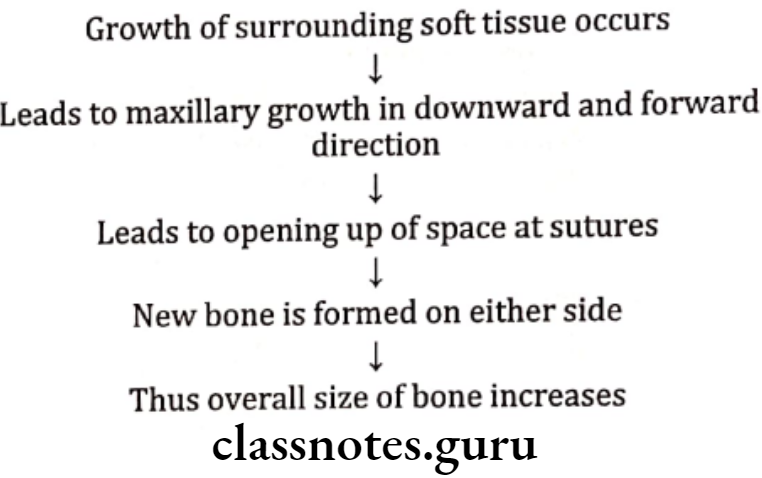
Surface remodeling:
- Remodeling changes
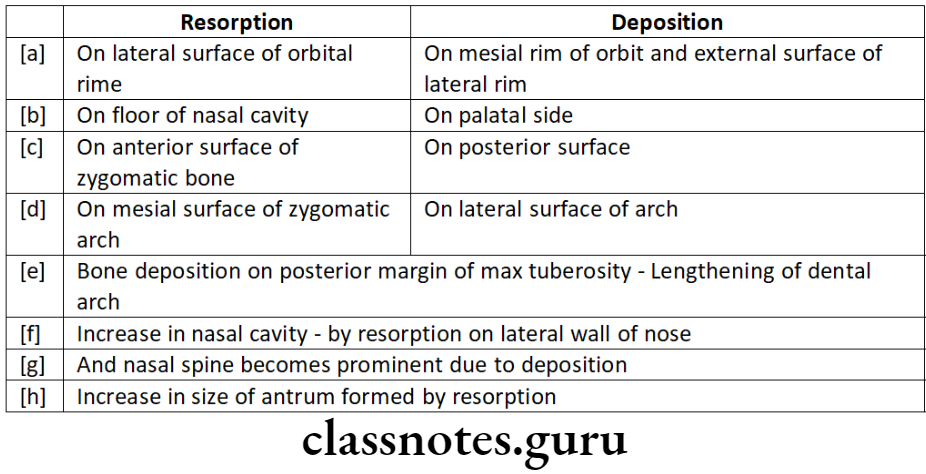


Cleft Palate:
Etiology:

Predisposing Factors:
- Increased maternal age
- Women who conceive later
- Racial
- Mongolids are at greatest risk
- Blood supply
- Reduces blood supply to the nasomaxillary arch
Treatment Of Maxilla:
The cleft palate is treated at different stages
- Birth-Initial assessment
- Pre-surgical orthopedics
- It is done by extra-oral strapping across the premaxilla

- 3 month – Primary lip repair
- 9 – 18 – Palate repair
- 2 years – Speech assessment
- 3 – 5 years – Lip revisional surgery
- 8 – 9 years – Initial interventional orthodontics
- 10 years – Alveolar bone grafts
- 12 – 14 years – Definitive orthodontics
- 16 years – Naal revisional surgery
- 17 – 20 years – Orthognathic surgery
Cleft Lip And Palate Short Essays
Question 1. Classify Cleft lip and Palate (1922).
Answer.
- Davis & Ritchie Classification:
- Group 1 – Prealveolar clefts – Involves only lip
- Group 2 – Post alveolar clefts
- Involves palate and alveolar ridge
- Group 3 – Alveolar clefts
- Involves the palate alveolar ridge and lip
- Veau’s Classification [1931]:
- Group 1 – Involves only soft palate
- Group 2 – Involves palate up to incisive foramen
- Group 3 – Involves palate, lip, and alveolar ridge unilaterally
- Group 4 – Involves palate, lip, and alveolar ridge bilaterally
- Carnahan’s Stripped ‘Y’ Classification:

- Block 1 and 6 – Lip
- Block 2 and 5 – Alveolus
- Block 3 and 4 – Hard palate anterior to incisive foramen
- Block 7 and 8 – Hard palate posterior to the incisive foramen
- Lahshal Classification:
- L – Lip
- A – Alveolus
- H – Hard palate
- S – Soft palate
- H – Hard palate
- L – Lip
Question 2. Role of Dental Surgeon in treating Cleft lip and palate/Surgical closure of Cleft lip.
Answer.
Surgical Goals:
- Symmetric, well-contoured lip
- Preservation of all functional landmarks
- Minimum scar tissue formation
Timing For Repair:
- Millard’s Rule – Child of 10 weeks old, 10 pounds weight and 10 gm Hb – For cleft lip
- Cleft palate – 12-24 months of age
Surgery:
- Cleft lip – by rotational advancement
- Cleft palate – Closure of soft palate followed by hard palate
Dental Care:
- Sound teeth are essential for the development of the alveolar process
- Malocclusion occurs due to the collapse of the maxilla
- Orthodontic treatment is essential
- Expansion of maxillary arch may be done
Orthognathic Surgery:
- For deficient maxilla – maxillary advancement done/Distraction osteogenesis
- The corresponding retrusion of the mandible is done
- The amount of advancement is largely dependent upon the amount of scarring of the lip and palate and on the elasticity of soft tissues.
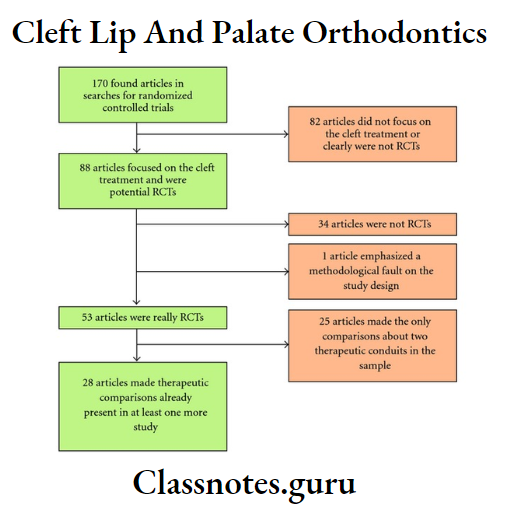
Cleft Lip And Palate Short Questions And Answers
Question 1. Cleft lip.
Answer.
Cleft lip
A cleft lip involves a breach in the continuity of the lip formed during facial development
Incidence: 1 in 600 – 1000 births
Associated Problems:
- Dental problems
- Esthetic problems
- Psychological problems
- Speech and hearing problems
Question 2. Teratogens.
Answer.
Teratogens
These are certain drugs/agents transmitted from infected mothers to features causing a disturbance in the growth and development of fetus
Examples Of Teratogens:
Infections Of Terotogens:
- Rubella virus
- Syphilis
Drugs Of Terotogens:
- Cortisone
- Methotrexate
- Dilantin
- Valium
- Mercepto purine
Question 3. Clinical features of cleft lip and palate
Answer.
Clinical features of cleft lip and palate
- Hypoplastic maxilla
- Shallow gingivo labial sulcus
- Nose deformity
- Hypoplastic teeth
- Supernumerary teeth
- Congenitally missing teeth
- Germinated, fused, conical teeth
- Feeding difficulties
- Posterior crossbite
Cleft Lip And Palate Viva Voce
- German measles during 1st trimester of pregnancy can cause cleft lip/palate
- Cleft lip occurs due to disturbances in 6-8 weeks of IU life
- A cleft palate occurs due to disturbances in 8-10 weeks of IU life
- Cleft palate repair should be attempted between 12-24 months of age
- Cleft lip repair is carried out at 3 months of age
- Bifid uvula is the mildest form of cleft palate
- The lower lip is least affected by cleft
- Increased maternal age increases the risk of clefting
- Cleft lip arises from the failure of fusion between the medial nasal process and maxillary process
